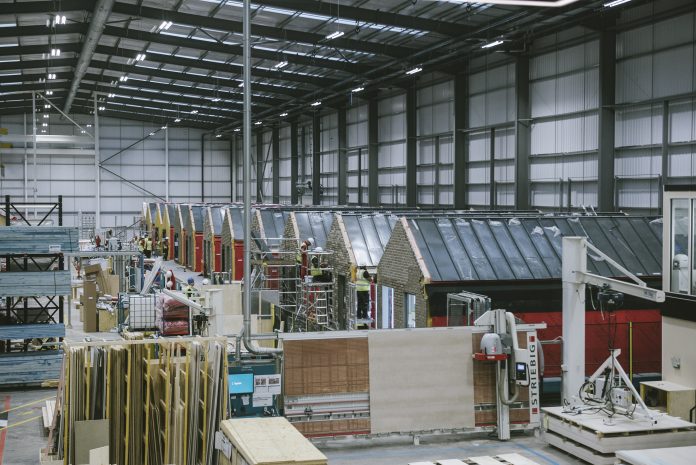The significant opportunities that modular homes offer to the Scottish construction sector must now be fully embraced, says real estate finance specialist Addi Spiers, a partner at law firm Addleshaw Goddard
What should construction firms be doing to modernise their approach and ensure they are best placed to meet government and commercial demand for homes, student accommodation, hotels and other commercial projects?
The Scottish and UK housing and building market is set for disruption amid a shortage of 25,000 homes and skyrocketing demand for student accommodation. Simultaneously, the traditional construction sector is set to change the way it operates in order to meet demand.
The times of bricks and mortar are changing for prefabricated modular homes. Built offsite in a factory, with fittings included, they can be built 50% faster than other methods of home construction. This makes them a significant growth driver for builders looking to reduce costs but boost outputs and meet the demand within the sector.
Modular construction potential
The potential for modular construction is exciting and leads many to believe that eventually, modular will overtake traditional construction methods due to sustainability factors.
Modular buildings are constructed to reduce waste and become adaptable to changing landscape needs while using less energy and reducing carbon emissions compared to more traditional methods. Many are now being fitted with solar panels and energy-efficient systems in order to be fully sustainable and self-reliant.
There is also an increasingly encouraging financial climate – indeed, a growing number of lenders are beginning to become more welcoming of this type of construction and lending against it. People can actually get mortgages with some of the main high street mortgage providers now considering modular construction as acceptable lending.
Slow uptake of technology in construction
At the same time, however, the UK construction industry has been slow at adapting to new technologies and changing its processes. The UK is falling behind its European counterparts when it comes to manufacturing and construction, with the concept of modular building undoubtedly still in its infancy.
With low costs, environmentally savvy features and recycling developments challenging the Scottish and UK housing market, it’s no wonder international investors are interested in the market.
That slow response to adapting to new technologies has seen international investors stealing a march by snapping up land and contracts on British soil. Recently, IKEA announced it was bringing its version of modular housing units to the UK under a pilot scheme with Worthing Council. Additionally, Japan’s biggest housebuilder has struck a £90m deal to provide thousands of modular homes in England.
Opportunity for modular homes in Scotland
Currently, the Scottish construction model means 83% of new builds are constructed using timber frames, but only a small percentage use more advanced methods of construction.
Recently, the opportunity for heightened offsite construction in Scotland was recognised with £1.2m funding investment given to the Construction Industry Training Board. The funding will support two projects to grow the sector through education. Candidates will be upskilled and trained in trade processes with the aim of modernising the sector and in turn boosting the Scottish economy.
Companies are also seeking investment through projects and government grants. To that end, the Scottish Government has established funding for housing, modern industrial and commercial property, and business-led research and development projects. The Building Scotland Fund, in particular, seeks to encourage innovation and collaboration across the construction sector. As of May 2019, the fund had supported the development of 5,500 new homes and 600 full-time jobs.
Nevertheless, the opportunity north of the border is far greater than this might indicate – according to a 2017 report, Scotland has the potential to produce 16,500 houses/apartments through offsite manufacturing.
To the Scottish housing market, this could mean an estimated output of £135m, while also fulfilling a desperate housing need. The unpredictability of Brexit has inevitably caused delays to construction across the UK, but in the second quarter of 2019 Scotland’s construction sector grew rapidly, with business enquiries for new projects and contracts growing.
Against a backdrop of modular homes bringing a new wave of construction methods, it’s safe to say that firms will be increasingly required to modernise their methods. With that in mind, research and development should be considered a top priority for the industry.
Battling the skills shortage
Furthermore, it’s predicted that there will have to be nearly 36,000 construction workers recruited per year until 2021 to keep up with demand, and while the government has recognised the need for training, companies within the sector still need to provide additional training to upskill existing and new employees. Alongside that, seeking out investment into practices and developing them through technology should be incorporated into growth strategies in order to boost productivity.
Fundamentally, a sector-wide conversation must be started in order to really drive momentum for change and longer-term acceptance. With the assistance of the UK and Scottish governments, clients and industry advisers, the sector must come together and invite discussion on how it can advance and the steps it must take to be more open to technology and transformation while safeguarding the industry.
All of this isn’t to say that it’s a completely perfect solution where investment is concerned. For instance, the insolvency risk associated with the module supplier has increased, and it’s very difficult to get someone else to step in halfway through.
If the main contractor is not also the module designer and supplier then it can be challenging to get them to accept the solvency and performance risk of the module supplier as a subcontractor, in turn providing the single point of responsibility that funders seek.
The alternative is construction management, but this is a procurement route that is only for the experienced developer, and funders are naturally wary of it.
Furthermore, if the modules are coming from overseas, often China, there are issues to be resolved around inspection/quality and transit risk and insurances.
Upfront payments amounting to 75%-plus of the contract price are usually required before the modules are delivered to site. In that instance, there are obvious issues around the need for advance payment bonds and performance security.
Among the best protection is the undertaking of detailed risk assessments and seeking identification upfront, while putting in place a robust supply agreement.
Finally, while a number of lenders on the high street are willing to give mortgages on modular homes, this will only become the market norm once there is more confidence in the long-term sustainability of modular homes.
Nevertheless, while the risk is certainly there, it’s clear that the current lack of housing in Scotland is a challenge that can be met through modular housing. Indeed, it offers a timely solution with wide benefits, including fresh employment and good availability of government grants, and its ability to meet the growing national need for new homes.
The associated reduced costs and upskilling requirements are set to create a generation of advanced workers who can work efficiently, and with precision, for lasting value.
With the right approach to risk assessment, and by adopting new technologies and investing in the trade, construction firms can safeguard their futures.
 Addi Spiers
Addi Spiers
Partner
Tel: +44 (0)1224 965 405
addi.spiers@addleshawgoddard.com
Twitter: aginsight
LinkedIn: Addleshaw Goddard
YouTube: AddleshawGoddardLLP

















